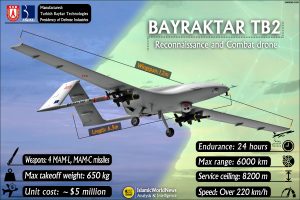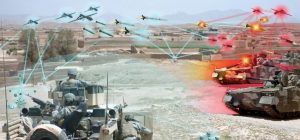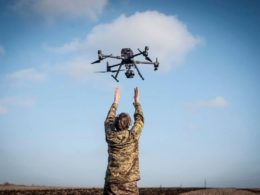 Volodymyr Horbulin, Chairman of the Supervisory Board of the Ukrainian Security Studies Institute, member of the National Academy of Sciences of Ukraine, member of the Supervisory Board of Ukroboronprom, former secretary of the National Security and Defence Council of Ukraine, has published an interesting and most important book: How to defeat Russia in the war of the future. In this article, Horbulin summarizes the main ideas in his publication.
Volodymyr Horbulin, Chairman of the Supervisory Board of the Ukrainian Security Studies Institute, member of the National Academy of Sciences of Ukraine, member of the Supervisory Board of Ukroboronprom, former secretary of the National Security and Defence Council of Ukraine, has published an interesting and most important book: How to defeat Russia in the war of the future. In this article, Horbulin summarizes the main ideas in his publication.Step 1. Ukraine’s military and political leadership must realize that modern warfare is very different from the war for which the General Staff is preparing
In September 2019, when drone attacks (claimed by Yemen’s Houthi rebels) struck two key oil installations inside Saudi Arabia and raised the risk of a drastic reduction in Saudi Arabia’s daily oil production, when a massive attack by Turkish drones in Syria at the end of February 2020 led to the destruction of Syria’s air defence, it became clear that something in warfare tactics had changed, that the world was witnessing a new technological leap in warfare and armaments.
The well-known American innovator Elon Musk immediately stated that in the wars of the future, fighter planes – even modern American F-35s – have no chance in the face of combat drones equipped with artificial intelligence systems. The war between Azerbaijan and Armenia only confirmed Musk’s statement – the size of the army and tanks are decisively not important in modern warfare. The Bayraktar TB2 operational-tactical attack drones, which Baku had purchased from Ankara in advance, allowed the Azerbaijani Armed Forces to dominate the battlefield.

This directly concerns Ukraine, a country that has been resisting Russian aggression for the seventh year in a row. It cannot be said that Ukraine has not taken certain steps towards developing new technologies. However, technological growth is proceeding too slowly, not systematically and without the participation of state management, that is, without strong political will.
Automation, robotization, global availability of technologies outfitted with intelligent programs, and the introduction of artificial intelligence will constitute the basis for advanced rearmament programs, which, in the end, will nullify the idea of nuclear deterrence. These processes have already begun and cannot be stopped. Not only are we seeing a tendency to develop national armies through autonomous weapons systems (robotization), but we are also witnessing a true technological tsunami!
In addition, modern warfare presupposes the absence of a clear front line. Mixed models of interaction are increasingly used to fight for and achieve specific objectives and political goals.
Step two. The enemy must be clearly identified and his weak points must be thoroughly explored. At the same time, the state should build and fine tune the principle of nation-wide resilience
Ukraine should not be held hostage to defence planning. The adoption of a National Security Strategy is the first positive step and reflects Ukraine’s position in a coordinated defence system.
The Military Security Strategy, or in other words, the new military doctrine, must clearly state that Russia is the enemy, and be that as it may, Ukraine will continue to resist and fight.
A positive shift has already taken place. At the end of May 2020, the Ministry of Defence announced that the principle of comprehensive defence will be applied in the Military Security Strategy of Ukraine. That means that the defence of Ukraine will include not only the Armed Forces, but also the entire Ukrainian society and all state authorities, which will counter the enemy throughout the country, using all forms and methods of struggle in compliance with the principles and norms of international law. This will be a very important step towards creating an asymmetric response.
As for the Russian Federation, there is much evidence of a steady decline across most aspects of political and technological life in the country. In 2020, several military development programs, such as the new Su-57 fifth-generation stealth fighter, the PAK DA (prospective aviation complex for long-range aviation – a next-generation stealth strategic bomber being developed by Tupolev for the Russian Air Force), the Il-112 (new high-wing military transport aircraft), the T-14 Armata tank (a next-generation main battle tank), etc. have long stalled, with numerous setbacks and delays.
In addition, the Russian Federation seriously lags behind the West, Türkiye and China, namely in such projects as the Orion heavy UAV, the Altius-U medium altitude long endurance drone, the Okhotnik stealth-capable heavy drone, etc.
All these trends were clearly visible in Syria and Nagorno-Karabakh, and Ukraine needs to identify them and build its own platform of defence capabilities, namely:
- a) Build a bloc of reliable, active allies and implement premises for an anti-Putin coalition.
- b) Exclude the Russian Federation from global markets and hinder Russia’s access to and acquisition of new technologies
- c) Ensure an active information policy
- d) Promote an asymmetric strategy
Step 3. It is imperative to define Ukraine’s asymmetric capabilities to counter the aggressor
The Military Security Strategy should outline a clear course for the formation of an effective system of asymmetric counteraction.
This would constitute a combined asymmetrical shield, which would be based on a number of new elements.
First, non-forcible measures aimed at counteracting aggressive actions. Information countermeasures, including cyber attacks, information and psychological operations, social networking and the mass media communications should be deployed in order to mobilize and develop counterintelligence, intelligence and special information institutions/structures, which will interact with civil institutions and public organizations.
Second, an effective territorial defence system.
Third, a professional army equipped with modern high-tech weapons. This army should be outfitted with a large number of special purpose units.
Fourth, the active use of paramilitary groups, private military campaigns and autonomous sabotage and reconnaissance units outfitted with modern weapons and protective elements.
Step 4. It is necessary to implement a non-forcible counteraction system
Ukraine’s asymmetric system will be based on a non-forcible counteraction network. To prevent repeated information terrorism launched by Moscow, it is imperative to implement the following measures: information and psychological operations, cyber attacks, active involvement of social networks and the media. Even more importantly, such a system is likely to prevent numerous killings and murders that Russian special services organize to intimidate citizens of their own country, as well as foreign states, including Ukraine. The system includes a surprisingly far-reaching and extremely complex range of tasks, which are aimed at the development of counterintelligence, intelligence and special information structures/institutions.
Finally, after so many years of war, we should finally realize that Russia’s war against Ukraine has demonstrated the absence of a clear front line. Therefore, Ukraine must create a multi-level system of deterrence based on existing structures and institutions, which, among other things, will be ready to tackle the problems before they actually arise.
Step 5. Ukraine must create and develop a national defence system
This will be a non-linear war, to the extent that there will not be any identifiable battlefields or front lines. The distinction between “civilian” and “military” is likely to disappear.

Therefore, in a broad sense, Ukraine’s territorial defence system should create an extremely hostile environment for Moscow, which will prevent Russian troops from operating effectively. Concurrently, the following principles of territorial defence should be introduced: a high level of autonomy for military units/divisions, a high level of technology (launching of effective rearmament programs) and close dialogue with the Armed Forces in matters of preparation and practice of using modern light weapons.
A well-prepared and farsighted system of territorial defence will improve the Armed Forces, turn them into a truly high-tech force and, at the same time, create a large number of reserve forces and reduce the number of Ukrainian active-duty troops.
Step 6. Ukraine must look forward and generate a radical transformation in the military
In our day and age, it is impossible to create and develop an army according to old criteria. The nature of threats and conflicts has changed, as have warfare methods and technologies, all of which requires a change in approaches to military organizational development. The armed forces of a state cease to be an independent organization, and become the core of the country’s defence forces. They perform their functions and are integrated into the general structure of the state’s military potential.
Advanced technology seems to remain a core parameter in current and future defense efforts, especially, as mentioned above, in troop command and control. The army must build a unified network capable of supporting its troops, i.e. a unified battlefield. Future wars will require prepared and well-equipped warriors who clearly know their place and duty in a battle formation.
As a result, Ukraine must create a modern compact army based on fundamental rearmament programs and high-tech systems.
Step 7. Technological innovations are key parameters in the wars of the future
Technological innovations should be the cornerstone of Ukraine’s entire defence system. Ukraine’s future security will depend on its ability to understand, adapt and implement technologies such as artificial intelligence, autonomous control and hypersonic systems.

This means that the military-industrial complex must be completely overhauled. Ukraine’s inflexible, ossified military-industrial complex should be reorganized into several independent holding companies, which will be joined by private enterprises. Accordingly, public-private consortiums can be created to perform certain tasks (programs).
Unfortunately, Ukraine is at war and does not have enough resources to implement such a large-scale program. Moreover, the technological resources of Ukraine’s defence forces, and mainly the army, are being seriously depleted. Consequently, when evaluating national military programs, Ukraine must focus on specific criteria:
- First, give top priority to technologies that can quickly respond – both today and tomorrow – to key vital threats to the country.
- Second, focus on technologies that will form the basis of an asymmetric shield, that is, non-linear technologies.
- Third, give preference to technologies that require relatively short production cycles to manufacture weapons and military equipment after the latter have been duly approved by the Armed Forces of Ukraine.
It is extremely important for Ukraine to start preparing for upcoming wars and for the wars of the future. In my opinion, this preparation should be reflected in future state rearmament programs as follows:
- The first state program should focus on improving the control system and armament programs of the Armed Forces of Ukraine.
- The second state program should be aimed at the development of modern electronic reconnaissance and warfare systems.
- Third state program – development of a state air defence system.
- Fourth state program – development of high-precision weapons.
- fifth state program – development of unmanned platforms and artificially intelligent weapons systems (killer robots).
The coming decade will be the most dangerous and unpredictable for Ukraine in its entire turbulent history. Therefore, one of the key tasks in the field of defence capability development is to turn future wars into meaningless and unsuccessful ones for the aggressor.





